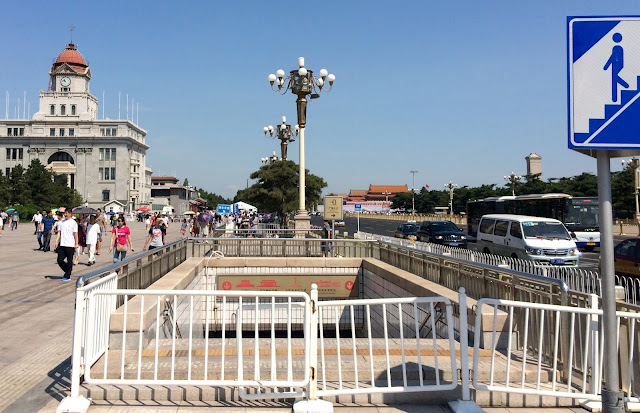 |
| The Hall of Prayer for Good Harvest is an all-wood structure constructed without nails |
On the south side of Beijing is the Temple of Heaven Park. Dating to 1420, the Temple was used by the emperors of the Ming (1368-1644) and Qing (1644-1912) dynasties to worship and offer sacrifices to pray for a successful harvest. At 675 acres, the park is larger than the Forbidden City and takes a few hours to visit. Based on Confucian design principles, the temple is actually more of an altar than a traditional temple. Most of the structures that survive in the park today date from the Qing era and include a mix of round temple halls and square bases methodically arranged within the park land that is scattered with 4,000 knotted cypress trees, some as old as 800 years. The highlight of the park sits near the north end and is the Hall of Prayer for Good Harvest. The original structure, which was built in 1420, burned after it was struck by lightning in 1889. Reconstructed a year later, the replacement is considered to be a true representation of the original and is a beautiful, three-tiered, structure constructed entirely of wood, without the use of nails, atop a three-tiered marble base.
 |
| The Imperial Vault of Heaven is surrounded by the Echo or "Whisper" Wall |
About one-quarter mile to the south and connected by a raised walkway is the Imperial Vault of Heaven, a round pavilion that dates to 1530 and is surrounded by the Echo Wall. Also known as the Whisper Wall, it is said that a whisper will travel from one end of its 633 feet and be clearly heard on the other end.
 |
| Looking north from the Round Altar, which was designed around the number nine |
At the southern end of the Temple of Heaven Park's north-south walkway is the Circular Mound (or Round) Altar, which also dates to 1530. Rebuilt in 1740, it is an open, three-tiered structure of white marble designed around the number nine. The Ancient Chinese believed that odd numbers represented masculinity and even numbers represented femininity. As the single largest odd-numbered digit, nine was considered the ultimate in masculinity and therefore used extensively in Imperial-era construction as a means of reinforcing the sovereignty of the emperor.
 |
| An incense burner at Yonghe Gong |
 |
A statue of Tsong Khapa, founder of Gelug Buddhism was
spared from destruction during the Cultural Revolution |
Beijing is not generally known for having great temples to visit, but it does have the distinction of being home to Yonghe Gong, one of the most renowned Tibetan Buddhist temples outside of Tibet. In Tibetan and Mongolian Buddhism, monks or spiritual leaders are referred to as Lamas. Because Yonghe Gong is a monastery, it is sometimes also referred to as "Yonghe Lamasery" or just "Lama Temple." Yonghe Gong means "palace of peace and harmony" which is fitting, given that its ornate structures create a calm setting within otherwise bustling Beijing. Dating to 1694, Yonghe Gong is made up of five Han Chinese and Tibetan halls filled with historic art. Between the halls are peaceful courtyards containing smaller pavilions, incense burners, and prayer wheels. During the Cultural Revolution, the Central Committee pursued a policy of destroying the "Four Olds" consisting of old customs, old culture, old habits and old ideas. Numerous temples were destroyed under this policy, but Yonghe Gong is said to have been spared due to the intervention of Premier Zhou Enlai.
 |
| Chefs carve Beijing Duck at Jinbaiwan Roast Duck Shunyi Branch |
 |
| Beijing Duck served with traditional condiments |
Since our weekend was about experiencing Beijing, we decided we couldn't leave without trying out some Peking (or Beijing as it's now called) Duck. With a little online research, we found a restaurant that would give us a truly local experience. When we arrived, we were pleased to discover we were the only Westerners there. Although ordering our food involved a comedy of pointing, gesturing and picture-drawing, our efforts were rewarded with a delicious dinner.
It's not difficult to find reasons to avoid Beijing. The prospect of air traffic delays, urban congestion, horrible air quality and government red tape add up to make make one feel like it may not be worth the effort. But in our brief weekend there, we avoided most of these problems and were rewarded by seeing some of Beijing's most enduring landmarks without having to go to great lengths for the experience.












Another fantastic report. It must have been as exciting and delicious as it sounds.
ReplyDeleteur weekend was about experiencing Universal Basic Income Beijing
ReplyDelete